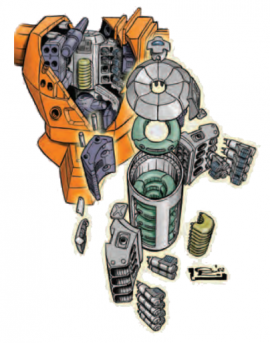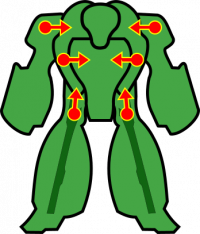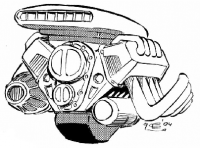Difference between revisions of "Engines"
m (→Fusion Engine Explosions: an urban legend that won’t die) |
m (→Fusion Engine Explosions: an urban legend that won’t die) |
||
| Line 84: | Line 84: | ||
| − | ''That puff of hot gas you see occasionally coming from the back of a fusion engine.'' | + | ''That puff of hot green gas you see occasionally coming from the back of a fusion engine.'' |
The fusion reactions in a BattleMech’s fusion engine occur only under very narrow conditions of temperature and pressure. Generally, the hotter and higher the pressure, the faster the reactions, and below a certain minimum, fusion simply ceases. | The fusion reactions in a BattleMech’s fusion engine occur only under very narrow conditions of temperature and pressure. Generally, the hotter and higher the pressure, the faster the reactions, and below a certain minimum, fusion simply ceases. | ||
Revision as of 18:15, 6 March 2021
Contents
Engines
Fusion Engines are the most common type of BattleMech and aerospace power plant in the BattleTech Universe. Fusion engines can supply great quantities of power, enough to power massive vehicles and all of their weapon systems, including directed energy weapons common on the modern battlefield. Yet when no thrust is generated, fusion engines are so efficient, they practically never need refuelling. If properly ventilated, controlled fusion reactions generate little heat. There are several sub-types of fusion engines available as well, each trading bulk for mass of the components.
In classic Battletech there are few types of power plants. In MW:LL we use following three:
Standard Engine
This is the most common fusion engine found all over the Inner Sphere. It is considered the standard of military grade equipment from the space faring ships down to the light scouting vehicles and tools. Military Fusion (Standard) Engines are mounted in the Center Torso.
Due to the location, Mech center torso does not receive extra damage from blown side torsos. Also STD engine have reduced damage transfer rate from destroyed back torso from 3× to 1.5×. This makes mechs equipped with standard engines considerably more resilient to grievous damage.
Some tanks, like the Partisan F or the Mars, have fusion engines.
Mechs with a standard engine lose 15% of their top speed when when their back torso has lost 80% of its armor. Once their back torso has lost all of its armor, an additional 10% of their top speed is lost (for a total of -25%).
Mechs using standard engines:
| Faction | Chassis | Variant |
|---|---|---|
| Inner Sphere | ||
| Catapult | Prime | |
| Warhammer | Prime | |
| Atlas | All | |
| Fafnir | A,D,F | |
| Clan | Locust IIC | All |
| Hellhound | Prime,A,C,E,F,G |
| All stats are current as of release 0.14.10 | |
Extra Light Engine
A technological leap lost to the fog of war. The XL engines are lighter, more expensive and prone to more easy undergo critical destruction than the STD counterparts. Other than that, they share the same power rating as the other engine types.
- Clan require 10 slots (6 in center torso; 2 per side torso) - 1.6x damage multiplier is applied due to blown side torsos and when overheating.
- IS require 12 slots (6 in center torso; 3 per side torso) - 2.0x damage multiplier is applied due to blown side torsos and when overheating.
- Damage Transfers from the Arms to Side Torso, Side Torso to the Center Torso and Legs to Side Torso (see Damage Types)
Most Mechs in MW:LL use XL engines, only exceptions being the STD engine variants (see table above)
Mechs with an XL engine lose 34% of their top speed when when their back torso has lost 80% of its armor. Once their back torso has lost all of its armor, an additional 26% of their top speed is lost (for a total of -50%).
Internal Combustion Engine
On the periphery and in the dire times elsewhere, the ICE engines find their use in not only utility vehicles and mechs, but also in some main battle tanks and even some rare battle mechs. Its power output is less than a fusion engine of similar mass, meaning an I.C.E. needs to be heavier in order to have the same engine rating of a fusion engine. Internal Combustion Engines cannot power energy weapons without power amplifiers, unlike fusion engines. Many I.C.E.s can use practically any combustible material as viable fuel. ICE Engines are used due to the extremely low cost and abundance of fuel everywhere.
Fusion Engine Explosions: an urban legend that won’t die
And you protest, “But I saw a ’Mech explode on the news in a blinding flash of light! It had to be a nuke!” Or is it, “Well, what about that MechWarrior that buried a bunch of Clanners in a canyon with his exploding reactor?” Or would you ask, “Well, what about Tharkad City?” Okay…
Fusion reactors do occasionally die in spectacular manners. But most of the time, the fireworks are not actually from an exploding reactor. What typically happens is that some heavy weapon manages to puncture the reactor itself. Since the reactor interior is a vacuum, air would get sucked in and mix with the plasma, stopping the fusion reaction. Kilograms of cold air mixing with a tiny mass of plasma… And, no, there’s not enough hydrogen in the reactor to really explode with the oxygen.
That puff of hot green gas you see occasionally coming from the back of a fusion engine.
The fusion reactions in a BattleMech’s fusion engine occur only under very narrow conditions of temperature and pressure. Generally, the hotter and higher the pressure, the faster the reactions, and below a certain minimum, fusion simply ceases. If you remember your ideal gas laws from chemistry…eh…the condensed version is that when you heat up a gas, it wants to expand. If it can’t expand, its pressure increases. When a gas expands, its temperature drops. Remember those rules of thumb. Fusion reactions drop when they get cooler. There are ways for the plasma to cool other than expansion. One way is when the plasma touches the relatively frigid walls of the reaction chamber. If they do, the plasma will chill so rapidly that fusion ceases instantly. That only leaves you with a puff of hot gas, with no continuing source to damage the reactor walls.
from: TechManual.pdf
Canon
http://www.sarna.net/wiki/Fusion_Engine
http://www.sarna.net/wiki/Fusion_Engine_-_XL
http://www.sarna.net/wiki/Internal_Combustion_Engine


